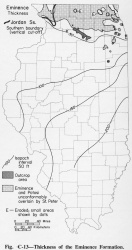Eminence Formation
Lithostratigraphy: Knox Dolomite Megagroup >>Eminence Formation
Chronostratigraphy: Paleozoic Erathem >>Cambrian System >>Croixan Series >>Trempealeauan Stage
Allostratigraphy: Sauk Sequence
Primary source
Willman, H. B., Elwood Atherton, T. C. Buschbach, Charles Collinson, John C. Frye, M. E. Hopkins, Jerry A. Lineback, and Jack A. Simon, 1975, Handbook of Illinois Stratigraphy: Illinois State Geological Survey Bulletin 95, 261 p.
Contributing author(s)
T. C. Buschbach
Name
Original description
Eminence Formation (Buckley, 1908, p. 286).
Derivation
Named for Eminence, Shannon County, Missouri.
Other names
History/background
It was traced into central Illinois by Workman and Bell (1948) and extended by Buschbach (1964) to northeastern Illinois, where it previously had been included in the Trempealeau or the Oneota.
Type section
Type location
Type author(s)
Type status
Reference section
Reference location
Reference author(s)
Reference status
Stratigraphic relationships
The Eminence Formation is a sandy dolomite overlying the Potosi Formation.
Extent and thickness
The formation underlies most of Illinois, except the northern part, where it was truncated by the sub-Tippecanoe unconformity at the base of the St. Peter Sandstone. Over the Ashton Arch it appears to thin to a feather edge. It is not exposed in Illinois. The Eminence is 50-250 feet thick in the areas where it is overlain by the Gunter Sandstone or the Oneota Dolomite (fig. Є-13).
Lithology
The Eminence Formation consists of light gray to brown or pink, sandy, fine- to medium-grained dolomite that contains oolitic chert and thin beds of sandstone. The formation contains less drusy quartz than the Potosi and is sandier and finer grained than the Oneota. In the southern third of Illinois the Eminence loses much of its sand and becomes an undifferentiated part of the Knox Megagroup. Sandstone at the base of the formation is differentiated as the Momence Sandstone Member. The irregular distribution of the Momence and the overlying Gunter Sandstone suggests that the formation may be bounded by minor unconformities, but otherwise the relations appear to be conformable. Except around the margins, sedimentation in the Illinois Basin was probably essentially continuous from Cambrian into Ordovician time. In the extreme northwestern part of Illinois, the Eminence Formation grades laterally into the Jordan Sandstone.
Core(s)
Photograph(s)
Contacts
Well log characteristics
Fossils
Age and correlation
Environments of deposition
Economic importance
Remarks
References
BUCKLEY, E. R., 1908, Lead and zinc resources of Missouri: American Mining Congressional Report Proceedings 10th Annual Session, p. 282-297.
BUSCHBACH, T. C., 1964, Cambrian and Ordovician strata of northeastern Illinois: Illinois State Geological Survey Report of Investigations 218, 90 p.
WORKMAN, L. E., and A. H. BELL, 1948, Deep drilling and deeper oil possibilities in Illinois: American Association of Petroleum Geologists Bulletin, v. 32, p. 2041-2062; Illinois State Geological Survey Report of Investigations 139.
ISGS Codes
| Stratigraphic Code | Geo Unit Designation |
|---|---|
